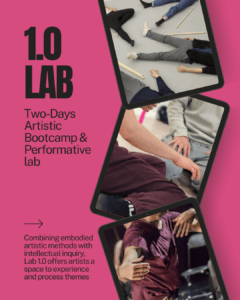 The event brought together teachers and students from the Department of Humanities and Arts of the European Humanities University and the Academy of Arts – voices from different backgrounds and practices that intertwined in dialogue and collaboration. What united them was curiosity: a shared willingness to step into uncertainty and see what might emerge.
The event brought together teachers and students from the Department of Humanities and Arts of the European Humanities University and the Academy of Arts – voices from different backgrounds and practices that intertwined in dialogue and collaboration. What united them was curiosity: a shared willingness to step into uncertainty and see what might emerge.
The Performance Lab became the heart of the event. It was, in essence, a rehearsal without certainty: no script, no predetermined outcome, only the willingness to test how bodies and ideas might intersect. Collaborators stretched into the space, sometimes awkwardly, sometimes with startling grace. There were collisions and hesitations, but also sudden alignments – instances when the disorder of identity seemed to crystallize into fleeting coherence. In those moments, what might have felt like fragmentation turned into connection, as if the instability itself carried its own form of logic.
What gave the Lab its intensity was not only the presence of participants but also the openness to invited voices, who complicated and expanded the dialogue. The room vibrated with multiple registers: personal stories woven into theoretical frames, improvisations that slid between vulnerability and strength, collective attempts that exposed the fragility of belonging while pointing toward new ways of being together.
By the second day, the work had shifted. What began as a dive into “disordered identity” – the recognition that inherited markers such as birthplace, language, or nationality can wound as much as they ground – evolved into an experiment in building something larger, literally and metaphorically. The creation of a collective art object became an act of anchoring: not the false stability of fixed categories, but a shared structure born of movement, negotiation, and touch.
The outcome was not a polished performance, nor was it meant to be. What lingered instead was the sense that transformation is rarely clean, often messy, and almost always collaborative. To drift is not necessarily to be lost; to belong does not require a fixed anchor. What the bootcamp revealed, in fragments and improvisations, is that meaning often appears in the very act of searching.
As the group looks toward the next steps, the traces of these two days remain: not finished works, but living questions. And perhaps that is the point – that art, at its best, resists easy closure and instead insists on the difficult, exhilarating work of staying in motion.
Given the depth of discoveries and the energy it generated, Performance Lab 2.0 is already being planned – a continuation of this dialogue between movement, thought, and transformation. The first Lab proved that a space of shared risk can become a space of renewal, and that the most powerful anchors are sometimes found in motion itself.